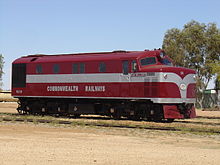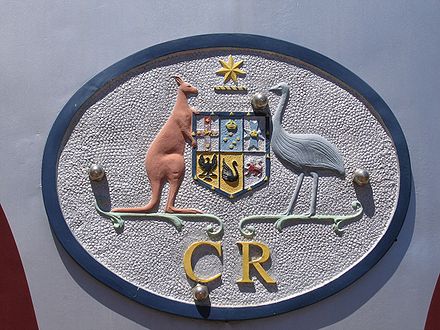- Commonwealth Railways
-
The Commonwealth Railways were established in 1912, as part of a government department, currently called the Department of Infrastructure, Transport, Regional Development and Local Government, by the Government of Australia to construct the missing link in the east-west transcontinental railway and the proposed Port Augusta to Darwin railway. It was absorbed into the Australian National Railways Commission in 1975.
Contents
Operated railways
Trans-Australian Railway
The Trans-Australian Railway (TAR) from Port Augusta, South Australia and Kalgoorlie, Western Australia, was commenced in 1912 and constructed to standard gauge of 1435mm (4 ft. 8½ in). Despite the inhospitable nature of the terrain[1] and wartime supply problems, satisfactory progress was made, and the two tracklaying machines, one working from each end, met near Ooldea, South Australia on 17 October 1917.
The promise to construction the TAR had been one of the principal inducements to Western Australia to join the Commonwealth of Australia, and it was for the purpose of surveying and constructing this railway that the Commonwealth Railways Department was initially formed. It was a matter of misfortune that its two termini were break of gauge stations connecting with narrow gauge lines (1067 mm - 3 ft. 6 in.) that formed part of the transcontinental link.
In 1937 the eastern end was extended south to Port Pirie, thereby effecting a reduction of one break of gauge in the trip across Australia, but at the same time establishing a three-gauge junction at Port Pirie.
Gauge-wise, the TAR remained isolated as part of the transcontinental link until 1968 when the Perth to Kalgoorlie standard gauge line was opened, while at the eastern end, the completion of the Broken Hill, New South Wales to Port Pirie standard gauge project in 1970 brought about the final union, in a common gauge, of the east and west coasts of Australia.
The Trans-Australian Railway remained fundamentally a main line; the only branch lines established being a short section from Pimba to Woomera (officially only ever known as a stores siding), and the Port Augusta to Whyalla railway which opened for traffic in October 1972.
North Australia Railway
The North Australia Railway (NAR) was the name given to the Northern Territory 3 ft. 6 in. gauge railway that extended south from Darwin to Birdum. Construction of this line [1] was commenced by the South Australian Government, being known then as the Palmerston and Pine Creek Railway, it opened in 1889.
When the administration of the Northern Territory passed from South Australia to the Commonwealth Government on 1 January 1911 the railway was transferred to Commonwealth ownership. The railway was initially placed under the control of the Administrator of the Northern Territory. At this time it was known as the Northern Territory Railway, but was transferred to the control of the Commonwealth Railways Commissioner in 1918.[2]
It was renamed the North Australia Railway (NAR) in 1926. Extensions to Birdum were completed in 1929, but during and following World War II the effective railhead was Larrimah, a few miles north.
The railway gained increased importance in the 1960s and early 70's through the haulage of iron ore from the Frances Creek deposits, about 140 miles south of Darwin. Ore traffic exceeded one million tons per annum, but unfortunately world ore prices dropped forcing the mine to close and other traffic was not enough to justify keeping the railway open. The line eventually closed in 1976.[3]
Australian Capital Territory Railway
The Australian Capital Territory Railway, of 4 ft. 8½ in. gauge, and five miles in length, connects the Australian Capital, Canberra, with the New South Wales Railways system at Queanbeyan.[4] This short section, opened in 1914, and was operated by the New South Wales Railways and it successors until 2003. Currently the line is controlled by Rail Corporation New South Wales, but is maintained under contract by the Australian Rail Track Corporation and passenger services are operated by CountryLink.
Central Australia Railway
 Narrow gauge locomotive NSU 58 preserved at the "Old Ghan Museum" in Alice Springs.
Narrow gauge locomotive NSU 58 preserved at the "Old Ghan Museum" in Alice Springs.
The Central Australia Railway (CAR) extended from Port Augusta in South Australia to Alice Springs, Northern Territory. Work on the first section of this railway was commenced by the South Australian Railways in 1878.[1]
Under South Australian ownership the railway, known as the Great Northern Railway, was extended in stages and reached Oodnadatta in 1891. The South Australian Government subsequently made offers to several syndicates to construct a line north from Oodnadatta to Pine Creek on the land grant system, however negotiations were unsuccessful and Oodnadatta remained the railhead.
Like the NAR, this railway passed to Commonwealth ownership on 1 January 1911, but continued to be operated by the South Australian Railways until the Commonwealth Railways took over operations on 1 January 1926. An extension of the railway to Alice Springs was completed in 1929.
In the years following World War II large tonnages of coal were railed from Leigh Creek and heavy demands were placed on the railway. In many ways the original line was inadequate; sharp curves and heavy gradients limited train loads, whilst light track and bridges restricted speeds and axle loads. Consequently a new railway, of 4 ft. 8½ in. gauge, was constructed to avoid the heavier graded terrain, and extended from Stirling North, via Telford (Leigh Creek) to Marree. During the construction stages, and after washaways on the old line, but with the new standard gauge line available to that point, complete trains of narrow gauge wagons were carried Pick-a-Back (Piggyback) style to Brachina, 88 miles (140 km) from Stirling North.[5][6] Completed in 1957, the new line enabled much larger quantities of coal to be carried.[7]
The old 3 ft. 6 in. gauge line between Marree and Hawker was closed, but between Stirling North and Hawker it was retained and used to a limited extent for some years. The track between Stirling North and Hawker was closed in 1972 and the section between Stirling North and Quorn handed over to the operations of the Pichi Richi Railway Preservation Society.
The country traversed by the CAR from Marree to Alice Springs was dry and poorly productive, and subject to periodic flooding which caused washaways and traffic disruptions. It was eventually decided that a railway constructed on flatter terrain further west of the existing line would offer a route less subject to flood damage. A new 4 ft. 8½ in. gauge railway, between Tarcoola and Alice Springs was constructed causing the narrow gauge section of the original Central Australia Railway to be closed in 1981.[8]
During construction the new line was known as the Tarcoola to Alice Springs Railway (TAS), but after opening its named was changed to the Central Australia Railway. The reusing of the name has led to some confusion about which railway is actually being referenced. A common way researchers have overcome this is by referring to the two railways as the narrow gauge CAR and standard gauge CAR"'.
Major passenger trains
The Ghan
The Ghan train commenced operation for the Commonwealth Railways when they took over the narrow gauge Central Australia Railway' from the South Australian Railways in 1926. It ran between Port Augusta and Oodnadatta initially, being extended to Alice Springs in 1929. When the new standard gauge Marree line opened in 1957 the journey was broken into two. A standard gauge run from Port Pirie to Marree, with the rest of the journey remaining on narrow gauge. Following completion of the standard gauge Tarcoola to Alice Springs line in 1980, the train was rerouted becoming an all standard gauge journey from Port Pirie using only modern rollingstock in the regular consists. This modern train was initially called The New Ghan on all marketing material, but eventually the New was dropped. In the late 1980s as part of a major refurbishment of the rollingstock the train was re-marketed as The Legendary Ghan.
Indian Pacific
The Indian Pacific had its inaugural run on 23 February 1970 when the first through passenger service operated between Sydney and Perth. The standard gauge connection had actually been completed by 12 January 1970. The carriages were owned by the Commonwealth Railways, but were considered Joint Stock of the Commonwealth, South Australian, Western Australian and News South Wales Railways for maintenance costings.
Passengers for Adelaide initially had to change trains at Port Pirie (to and from the west) or Peterborough (to or from the east) until Crystal Brook to Adelaide was converted to standard gauge - transfers then took place at Port Pirie, until the service was re-rerouted to travel via Adelaide. The first Indian Pacific into Keswick Passenger terminal was on 1986-08-17.
Trans-Australian
The Trans-Australian Passenger train ran between Port Augusta and Kalgoorlie. It began in 1917 and was eventually cancelled in 1991 (by the CR successor organisation Australian National) following poor patronage and a severe cut back in the frequency of the service.
Initially it was all sleeping class with only irregular way side situp passenger accommodation being provided. In the 1960s regular situp was provided, but this was eventually withdrawn. Situp was again introduced in 1981 when it was added to the Trans-Australian and Indian Pacific services.
Gauges
Narrow gauge
The Commonwealth Railways operated Narrow Gauge railway track with 3 foot 6 inch (1067mm) spacing between rails on the Central Australia Railway (Port Augusta via Quorn and Marree to Alice Springs) and North Australia Railway.
Standard gauge
The Commonwealth Railways operated Standard Gauge railway track with 4 foot 8½ inches (1435mm) between rails on the Trans-Australian Railway and Central Australia Railway (Tarcoola to Alice Springs and Port Augusta, via Leigh Creek to Marree).
Commissioners
-
This transport-related list is incomplete; you can help by expanding it.
- 1917 - 1929 - Mr Norris G. Bell
- 1929 - 1948 - Mr G A Gahan
- 1948 - 1960 - Mr P J Hannaberry
- 1960 - 1980 - Keith Smith [9]
Demise
In 1975, the Commonwealth Railways was merged in the newly formed Australian National Railways Commission (ANRC). The ANRC was owned by the Commonwealth of Australia and formed from the former Commonwealth, South Australian (non-suburban) and Tasmanian railways. It traded under the name Australian National. Its operations extended from Kalgoorlie to Alice Springs and to the borders with Victoria and New South Wales, as well as all railways in the state of Tasmania.
ARTC
With the separation of above rail (trains) and below rail (track), the above rail part was privatised, with provision of open access to other operators, while the below rail part (ARTC) expanded to include most of the interstate standard gauge network of the mainland states.
Namesake
Not to be confused with the Commonwealth Railway of the US.
References
- ^ a b c Ways in the Wastelands, Gigney, M.E. Australian Railway Historical Society Bulletin, November 1956 pp149-160
- ^ The North Australia Railway, 1911-1939, Harvey, J.L. Australian Railway Historical Society Bulletin, August & November 1970 pp169-192;241-259 February, March, April 1971 pp39-47;58-65;73-88
- ^ The Closure of the North Australia Railway, Bayley, William A. Australian Railway Historical Society Bulletin, June 1977 pp121-127
- ^ Railways in the Australian Capital Territory, Singleton, C.C. Australian Railway Historical Society Bulletin, November 1967 pp244-252
- ^ The 'Pick-a-Back' Train Buckland, J.L. Australian Railway Historical Society Bulletin, December 1955 pp157-162
- ^ Carpe Diem - Seize the Day Smith, Keith A. Australian Railway History March 2006 pp103-112
- ^ The Stirling North-Maree Standard Gauge Railway, Castle, B.J. Australian Railway Historical Society Bulletin, February,1958 pp17-22
- ^ The Demise of the Central Australia Railway, Reid, Graham Australian Railway Historical Society Bulletin, January 1996 pp10-23
- ^ http://www.abc.net.au/7.30/content/2001/s331040.htm
Further reading
- Overland to Perth in 1928, Henshaw, C.H. Australian Railway Historical Society Bulletin, April 1964
External links
Categories:- Defunct railway companies of Australia
- Government railway authorities of Australia
-
Wikimedia Foundation. 2010.

